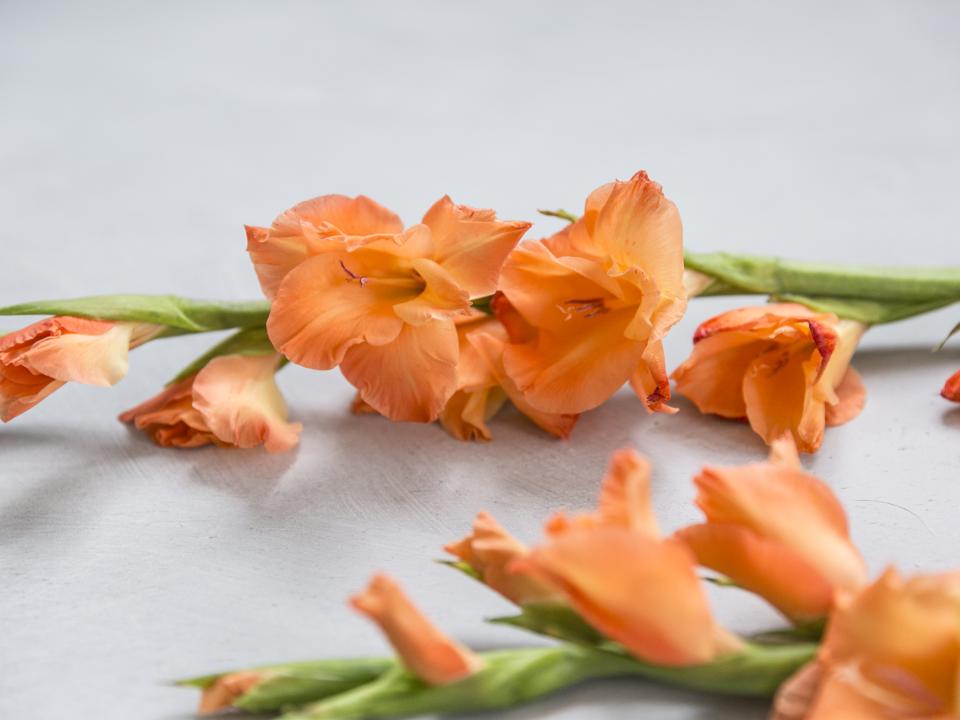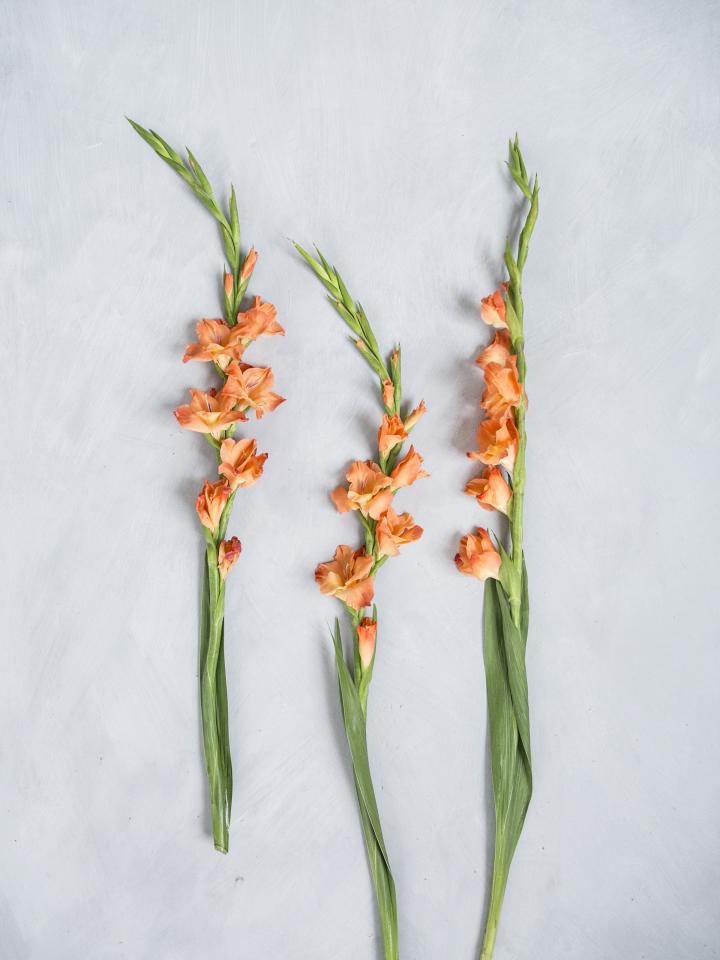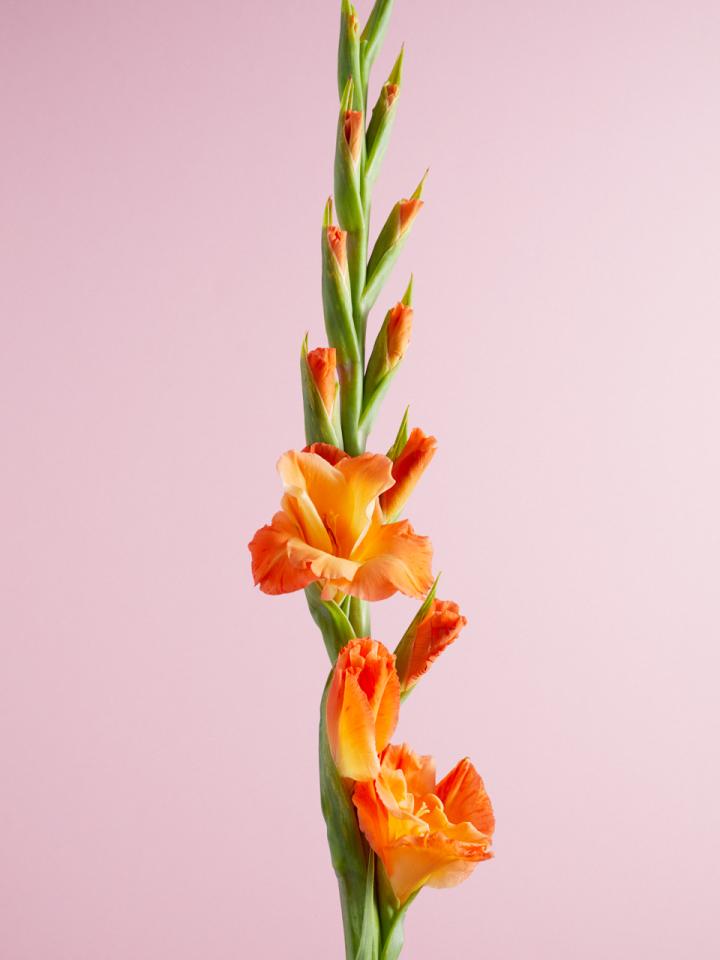GLADIOLUS: CHARACTERISTICS AND FLOWERS
The gladiolus stands out because its colourful flowers bloom on both sides of its long, slender stem. The leaves of the gladiolus resemble the shape of a sword, which is why the gladiolus is also sometimes known as a sword lily. Gladioli come in white, red, yellow, pink, purple, orange, cream and with multiple colours per flower. Some varieties are fragrant, others are not. Gladioli are popular as cut flowers in bouquets, but are also beautiful as garden plants.
Gladioli belong to the lissen family (Iridaceae), which also includes plants such as iris, crocus and freesia. Gladiolus usually blooms in summer, from July, until the first frosts in autumn.
TYPES OF GLADIOLI
There are over 250 different varieties of gladiolus, the best known of which are often hybrids of a number of different species. Roughly speaking, gladioli can be divided into two groups: large-flowering and small-flowering varieties. The large-flowering gladiolus group is the biggest.
- Large-flowering gladioli: this species, also called Gladiolus Grandiflorus, has large flowers with wide petals in a variety of colours. These gladioli grow relatively large (50-120cm) and have around 20-30 flowers per stem. The large-flowering gladiolus is a real eye-catcher in bouquets and is also popular as a garden plant. There is a huge variety of colours, shapes and sizes of large-flowered gladioli.
- Two well-known large-flowered varieties are Butterfly gladioli (with slightly wavy edges and unusual colour combinations) and Primulinus gladioli (where the upper flower petals grow over stamens).
- Small-flowering gladioli: this is the collective name for all gladioli that are not large-flowering, sometimes called mini gladioli. Small-flowering gladioli have smaller flowers, grow lower (50-70 cm high) and flower earlier than large-flowering gladioli. Thanks to their more compact flower clusters (around seven flowers per stem), they are ideal to grow in pots and for smaller bouquets. Small-flowering varieties also have a huge variety of colours and shapes.
- Three well-known varieties of small-flowered gladioli are Nanus (small gladioli flowers in bright colours), Colvillii Alba (white flowers) and Tubergenii (one of the oldest varieties there is).
THE FRAGRANT ABYSSINIAN GLADIOLUS
The Abyssinian gladiolus, or Gladiolus callianthus (‘Murielae’), is native to Ethiopia (formerly called Abyssinia). The plant was previously not recognised as a gladiolus and was thought of as an oddity. The Abyssinian gladiolus has fragrant, white flowers with a dark purple centre and golden pistils. This graceful species does not grow taller than 60 centimetres.

GLADIOLI IN YOUR VASE: CARETAKING TIPS
Have you been given, picked or bought a gorgeous bunch of gladioli? Then you'll want to enjoy them in your vase for as long as possible. Check out the tips below to keep your looking gladioli beautiful and fresh, and take a look at this article with tips and tricks for looking after cut flowers in the best possible way.
- Choose a tall, sturdy vase. Gladioli have quite long stems, so make sure the vase is large and stable enough to accommodate them.
- Put the gladioli in a clean vase as soon as possible after you bring them home.
- Gladioli hack: remove the topmost flower bud of the stem. This ensures that the gladiolus doesn't send all its energy to its tip, distributing the energy better and causing the flower buds to open more evenly and vigorously. This also prevents the gladiolus from becoming too heavy and snapping.
- Cut the stems at an angle with a sharp, clean knife.
- Remove any lower leaves so they don't hang into the vase water and cause bacterial growth.
- Place the gladioli in a clean vase in lukewarm tap water.
- Add cut flower food to the water for a longer shelf life.
- Change the vase water regularly and cut the stems at an angle again if necessary.
- Do not put the gladioli in a draught, near a heater, next to a fruit bowl or in direct sunlight.
Want to pick gladioli from your own garden to put into a vase? Cut the stems as soon as the bottom bud is open and follow the tips above for best results.
how to plant GLADIOLUS
Gladioli grow from a tuber, which looks a bit like an onion. Want to plant gladiolus tubers into the open ground or in a pot? See our advice on planting garden plants here, and read the tips below for planting gladiolus.
- Plant the bulbs between mid-April and the end of May (when the chance of frost has passed). This means you'll be able to enjoy the beautiful flowers as soon as summer!
- Plant the bulbs in a sunny, sheltered spot, such as near a wall or fence facing south.
- Plant the tubers about 10 cm deep and about 10 cm apart. Make sure that the tip (the narrow side) of the tuber is facing upwards, as that's where the shoots appear from.
- Plant gladioli in groups, e.g. five of them grouped together. Gladioli are vulnerable to wind, and if you put them together the plants will support each other.
- Water well after planting and keep watering in dry weather.
GLADIOLI: LOCATION AND CARETAKING
- Gladioli thrive best in a sunny spot.
- Make sure you have calcareous, fertile soil with good drainage (any excess water should be able to drain easily).
- Give the gladioli a little organic fertiliser in spring. This is especially necessary with sandy soil. In clay soil, fertilising is not necessary.
- Water gladioli sufficiently during dry, warm periods.
- When the stems grow longer, you may need to support them with a stick or plant support.

PRUNING GLADIOLUS
You can remove spent flowers immediately after flowering, so that the plant uses energy to grow other flowers. Leave the green leaves, however. When gladiolus has finished flowering and the flower stems are turning brown, you can cut the stems back to just above the ground.
WINTER-PROOFING AND STORING GLADIOLUS: A STEP-BY-STEP PLAN
Gladioli are not hardy, meaning they will not withstand freezing temperatures. If you want to enjoy your gladioli again next year, you need to remove the bulbs from the ground before the first frost. Here's how to do this:
- Carefully remove the bulbs from the ground with a spade.
- Clean the tubers by gently removing the soil.
- Inspect the bulbs, disregarding any that are rotting and look soft or damaged.
- Cut off the remaining stems to about 5 centimetres above the tuber.
- Store tubers in a dry, cool and frost-free place, such as in a shed or unheated garage. Make sure they get enough oxygen. Store them in a paper bag or cardboard box, but not in a plastic bag or in plastic wrap.
- In spring (after the chance of frost has passed), you can replant the bulbs.
ARE GLADIOLI POISONOUS?
Yes, gladioli are poisonous to both humans and domestic animals. The bulbs, leaves and flowers are poisonous. If ingested, they can cause nausea, vomiting, diarrhoea and irritation of the mouth and throat. Take care with this plant around children and animals such as dogs, cats and horses. In case of ingestion and/or intensive skin contact, consult a vet or doctor immediately.
GLADIOLUS SYMBOLISM
The gladiolus has heroic significance. The name comes from the Latin gladius, meaning sword. The flower represents struggle, strength victory and pride. This meaning goes all the way back to Roman times, when gladiators literally fought in the arena for death or gladioli. If a gladiator won, he was buried under gladioli.
GLADIOLUS ORIGINS
Gladioli are native to South Africa, southern Europe and Asia. They used to be used for their supposed medicinal properties and were even eaten (modern-day gladioli are not edible - do not try this!). In Roman times, gladioli were also used in gladiator fights, with the winner being buried under gladioli (‘death or gladioli’).
In Western Europe, the gladiolus was introduced in the 17th century. They became a popular addition to monastery gardens and were appreciated for their diverse colours and varieties. Today, gladioli are popular worldwide as cut flowers and garden plants.















